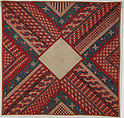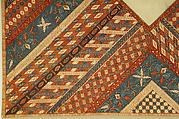Headcloth
Not on view
Javanese men wear headcloths (iket kepala) consisting of small roughly square textiles that are wrapped according to local and regional tradition. Once part of both everyday and formal attire, iket kepala are now worn only on occasions that require customary dress, such as weddings, or by performers in traditional art forms, such as dance or gamelan orchestras. Although created on a single piece of cloth, the radiating batik designs on thisiket kepala are intended to make it appear as though it were a patchwork textile pieced together from strips of fabric.
Such faux patchwork batik, referred to as tambal ("beggar’s cloth"), is made on the north coast and in the interior of central Java. The simulated patchwork designs are said to imitate the patchwork garments once worn by the poor out of necessity and by priests as a symbol of their vows of poverty. In some instances, priests themselves reportedly wore tambal batik rather than actual patchwork. The designs on north coast tambal batiks, such as this one, are generally purely decorative. In central Java, however, certain motifs and patterns were believed to have magical or protective powers. Therefore, though patchwork was once associated with poverty, even the wealthy sultan of Yogyakarta in central Java might wear a tambal batik on certain occasions to help ensure the well-being of his lands and people.
Due to rights restrictions, this image cannot be enlarged, viewed at full screen, or downloaded.
This artwork is meant to be viewed from right to left. Scroll left to view more.



